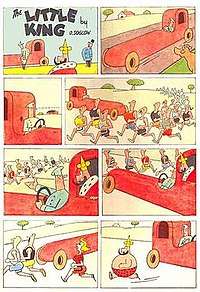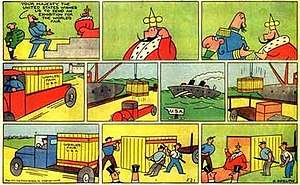The Little King
| The Little King | |
|---|---|
 An eight-panel installment of Otto Soglow's long-lived comic strip The Little King | |
| Author(s) | Otto Soglow |
| Current status / schedule | Concluded |
| Launch date | June 7, 1930 |
| End date | 1975 |
| Syndicate(s) | King Features Syndicate |
| Genre(s) | Gag-a-day, Pantomime comics |
| Preceded by | The Ambassador |
The Little King was an American gag-a-day comic strip created by Otto Soglow, telling its stories in a style using images and very few words, as in pantomime.
Publication history
Soglow's character first appeared on June 7, 1930 in The New Yorker and soon showed signs of becoming a successful strip. The Little King began publications in comic book issues from 1933, was licensed for a 1933-34 series of animated cartoons by Van Beuren Studios and featured in an advertising campaign for Standard Oil.[1]
It became evident early on that William Randolph Hearst was determined to add The Little King to his King Features Syndicate newspaper strips, but he was hindered by Soglow's contractual obligations with The New Yorker. While seeing out the final period of the contract, Soglow produced a placeholder strip for King Features, The Ambassador, quite similar to The Little King in characters, style and story situations.[2] One week after its final publication in The New Yorker, The Little King resumed as a King Features Sunday strip, on September 9, 1934.[1]

The strip continued a successful run with several more animated cartoon appearances and advertising campaigns,[3] and Soglow was awarded the 1966 National Cartoonists Society Reuben Award for the strip.[4] The Little King ran until Soglow's death in 1975.
Format
The strip is notable for having virtually no dialogue; the title character never speaks. The Ambassador was nearly identical in format, and the main characters of the two strips were similar. When The Ambassador gave way for The Little King in 1934, the reader could not be certain if it was the Little King who had arrived into Hearst syndication or the Ambassador who had removed some disguise.[1]
The Little King (mustachioed, bearded, and clad in velvet and ermine) was small of stature, but as wide as he was tall. He was a childlike, cheerful fellow who lived to have fun. The final panel of the comic strip often showed His Majesty pursuing a hobby, playing a children's game, flirting with a pretty woman, or otherwise enjoying himself in an unkingly fashion while neglecting his "official" duties.
Animated Theatrical shorts
All cartoon shorts were produced by Van Beuren Studios except where otherwise noted. All of the theatrical shorts were released to DVD by Thunderbean Animation.[5] As in the comic strips, the Little King never speaks in the 1933 and 1934 shorts except for a brief sequence in "Marching Along" (1933).
1933
- A.M. to P.M. (Part of Aesop's Fables Series)
- A Dizzy Day (Part of Aesop's Fables Series)
- The Fatal Note
- Marching Along
- On the Pan
- Pals (aka Christmas Night)
1934
- Jest of Honor
- Jolly Good Felons
- Sultan Pepper
- A Royal Good Time
- Art for Art's Sake
- Cactus King
1936
- Betty Boop and the Little King (produced by Fleischer Studios)
Collections
- The Little King (1933), Farrar & Rinehart[6]
- Cartoon Monarch: Otto Soglow and the Little King (2012), IDW Publishing's imprint The Library of American Comics
References
- 1 2 3 Gardner, Jared, The Comics Journal (October 29, 2007). "Otto Soglow and The Ambassador (excerpt)". from The Comics Journal #286
- ↑ Time Magazine (September 17, 1934). "Old King, New Kingdom".
- ↑ Gallery of classic graphic design featuring The Little King as spokesman for Royal Gelatine and Pudding
- ↑ National Cartoonists Society. "The Reuben".
- ↑ Thunderbean Animation
- ↑ "GDC entry". Retrieved 25 April 2013.
External links
| Wikimedia Commons has media related to The Little King. |
- Don Markstein's Toonopedia. "The Little King". Archived from the original on November 12, 2015.
- The Big Cartoon Database. "Aesop's Fables".
- The Big Cartoon Database. "The Little King".
- Stanley Stories: "Henh! Henh! Hoppin' on the Little King Bandwagon: selections from Dell Four-Color 677, 1956